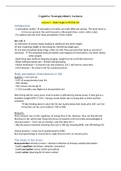Summary
Summary of all 7 lectures of 'Cognitive Neuropsychiatry' UU masters course
- Course
- Institution
In this document, all 7 guest lectures from the 'Cognitive Neuropsychiatry' course of the master Neuropsychology at Utrecht University, are summarized. All important concepts and theories are described as well as conclusions from research articles. The 7 lecture topics are: (1) eating disorders; (2...
[Show more]



